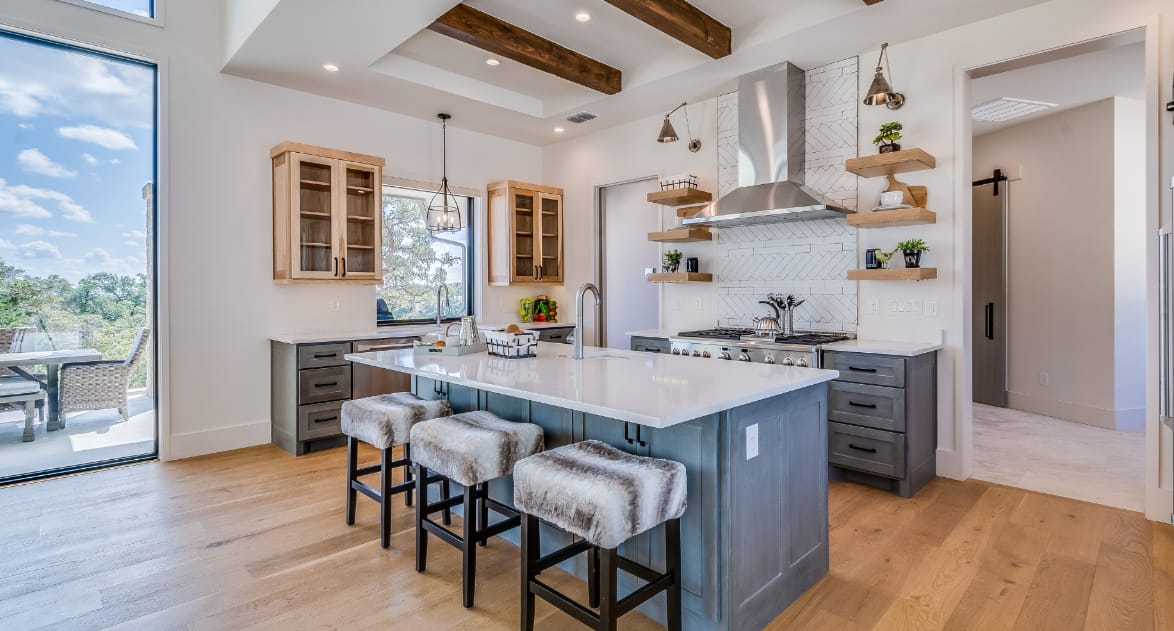Ceiling beams are no longer just a structural necessity; they’ve become design must-haves. Whether you want to add a rustic charm, industrial edge or minimalist elegance, ceiling beams fit all of your interior styles. They have become more popular among homeowners and interior designers, who appreciate their power to transform a home’s built environment while adding attention-grabbing focal points.
Thank you for reading this post, don't forget to subscribe!Wondering what ceiling beams could do for your home? This guide will walk you through all the things you need to know—from the different types of beams available to design ideas, installation guidance, cost breakdowns and maintenance tips.
What Are Ceiling Beams (And Why Are They Popular Right Now)?
Horizontal, long structures attached to the beams are called ceiling beams, which can be functional or decorative. Historically, they were crucial elements of a building’s structure, rafters holding up the roof or ceiling. Today they have become more of a decorative element, giving a room depth, texture and architectural interest.
Why are they so popular?
Versatile Aesthetic Charm: Ceiling beams suit an array of settings, from modern to vintage.
Improved Space Definition: Day curtains can visually separate open areas without them being physically walled-off.
Aesthetic Warmth: Wood is a natural material that brings warmth and personality to a space.
Perennial Favorite: Ceiling beams never lose their appeal, so your house will look as fashionable as the day you built it for decades to come.
Types of Ceiling Beams
The type of ceiling beam will depend on your aesthetic, budget and structural needs. Here’s a brief rundown of the most popular options out there:
Wood Beams
Timeless and versatile, wood beams continue as a popular choice. Raw, stained or painted, they feel warm and earthy. Perfect for rustic, farmhouse, or traditional styles.
Pros: Classic, natural appearance, durable.
Cons: Costly, weighty, needs up-keep to avoid warping or rotting over time.
Metal Beams
Metal beams are a popular choice for a contemporary, industrial aesthetic. They’re elegant, powerful and commanding.
Pros: Low maintenance, durable, light weight
Pros: More durable; suitable for certain aesthetics. Cons: Higher initial cost.
Faux Beams
Faux beams, usually made from polyurethane or lightweight wood substitutes, offer the aesthetics of real wood or metal without the cost or heft.
Pros: Inexpensive, light, easy to put in place, comes in many styles
Pros: Does not feel inauthentic, doesn’t feel cheap
Reclaimed Beams
Sustainable and steeped in history, reclaimed wood beams come from old buildings. Their character and imperfections tell a story.
Pros: Sustainable, unique details, rustic charm.
Difficulties: Availability is not constant and may require additional planning.
Ceiling Beams: Design Ideas for Strong Statement Elements
Ceiling beams are highly versatile and can be customized to different types of interior design styles. Here are some mad libs ideas to get you started.
Rustic Farmhouse
Distressed wood beams can add warmth and rustic charm to a living room or kitchen. Mix with neutral colors and textured fabrics for the ideal farmhouse style.
Modern Minimalist
Pick sleek, linear beams painted black or white, which sets off clean lines and a monochrome color scheme. These beams are superb in modern spaces.
Industrial Loft
Pair exposed metal beams with concrete textures, steel fixtures and big windows for an edgy industrial vibe.
Beachy Coastal
Combine painted white wooden beams with breezy, light-flooded interiors to achieve that tranquil, seaside aesthetic.
Vaulted Elegance
Use thick, dark wood beams to highlight vaulted ceilings for a striking contrast with white walls. Ideal for areas where luxury is the goal.

How to Install Ceiling Beams
Looking for a DIY ceiling beam project? Here’s a step-by-step process for that.
HERE’S WHAT YOU’LL NEED: Tools and materials
- Beams (real or faux)
- Drill and screws
- Stud finder
- Measuring tape
- Paint/stain (optional)
- Ladder or scaffolding
- Installation Steps
Measure and Plan
Take a measuring tape to indicate where each beam will be placed. Space them evenly for a symmetrical look.
Locate Studs
Reinforced with ceiling joists using a stud finder.
Prep the Beams
If you need to paint or stain your beams, sand them before installation.
Attach Mounting Brackets
Attach that to the ceiling joists by adding brackets or wooden blocks to hold the beams.
Install the Beams
Screw each beam into the mounting brackets with screws and a drill.
Finishing Touches
If required paint or stain touch up. Take a step back and admire your new masterpiece!
NOTE: With heavier beams or trickier designs, seek professional assistance for safe installation.
Material Estimate for Ceiling Beam
Ceiling beams come at a wide range of prices depending on the material used, the size of the beam and how these have been put in place. Here’s a rough breakdown for reference:
Wood Beams: $15–$30 per linear foot
METAL BEAMS: $25–$50 PER LINEAR FOOT
Faux Beams: $6–$10 per linear foot
Reclaimed Beams: $10–$25 per linear foot (depending on source & condition)
Depending on complexity, professional installation can run an additional $300–$1,000 on your budget.
Maintenance Tips to Keep Your Beams Looking Beautiful
If you want to keep your ceiling beams in shape, consider some of these easy upkeep tips:
Dust Regularly: Use a soft cloth or microfiber duster to avoid buildup.
Annual inspection: Look for cracks, warping, or pests to catch problems early.
Treat Wood Beams: Regularly apply sealants or finish to protect beamed wood from damage.
Wipe Down Faux Beams: Wipe with a damp cloth; use mild detergent if necessary.
Dodge Extra Moisture: Help your beams stay dried out, to steer clear of mildew or rot — especially with wood or reclaimed beams.
10 Reasons You Should Add Ceiling Beams to Your Home
Ceiling beams are not only a design feature — they are an opportunity to introduce personality, character and warmth to your home. From modern sophistication to rustic charm, ceiling beams offer the versatility to align with your vision.
In addition to adding an outstanding look, they also enhance the architectural beauty of your home, which helps boost its value. With the right materials, a thoughtful design, and the proper maintenance, your ceiling beams will leave a lasting impression for years to come.
Take the Next Step
Get ceiling beams in your home and change your space today! Whether you take on a DIY project or hire pros, the result is sure to impress. Want more design inspiration? Be sure to bookmark our blog for additional expert tips and ideas!



